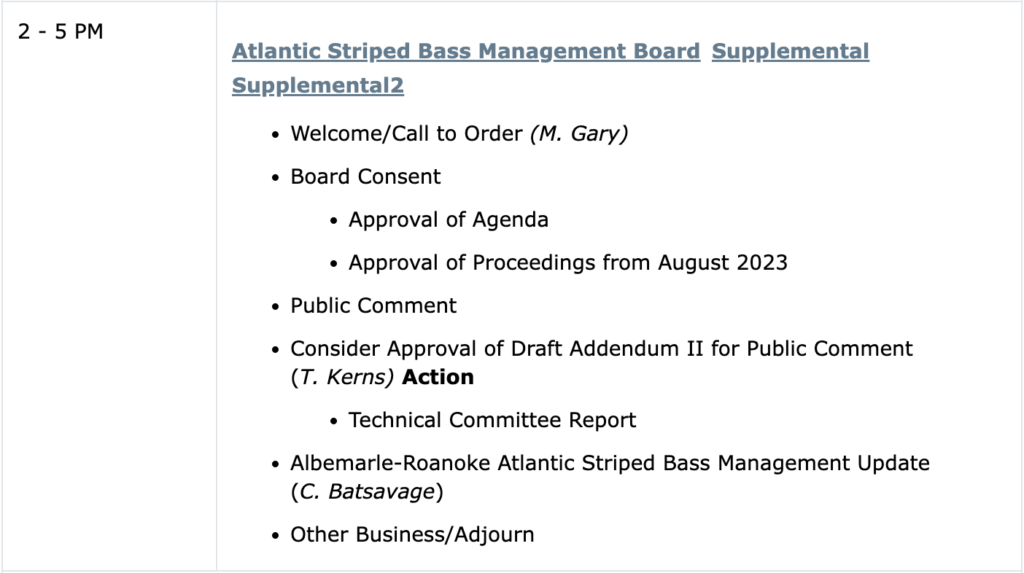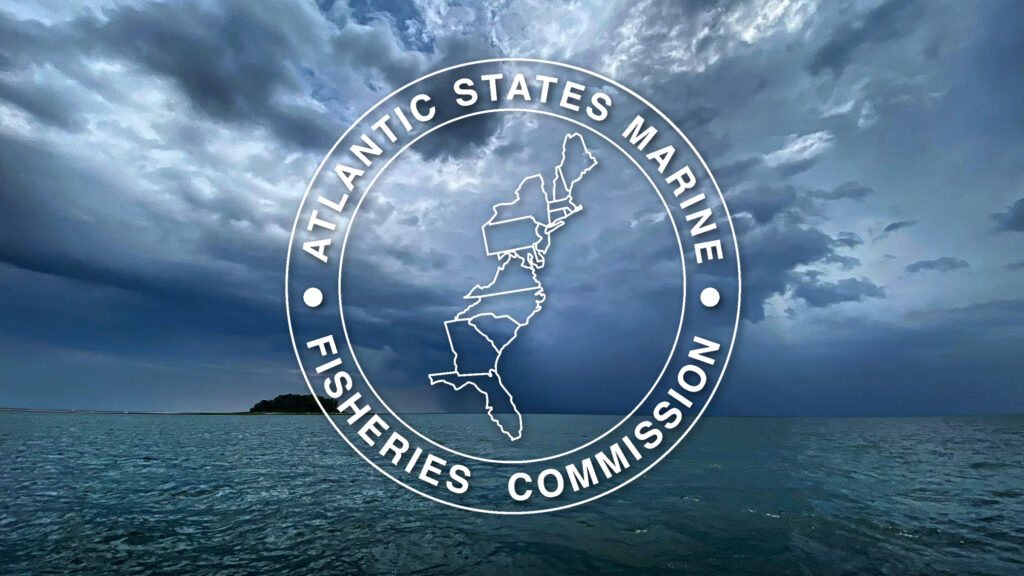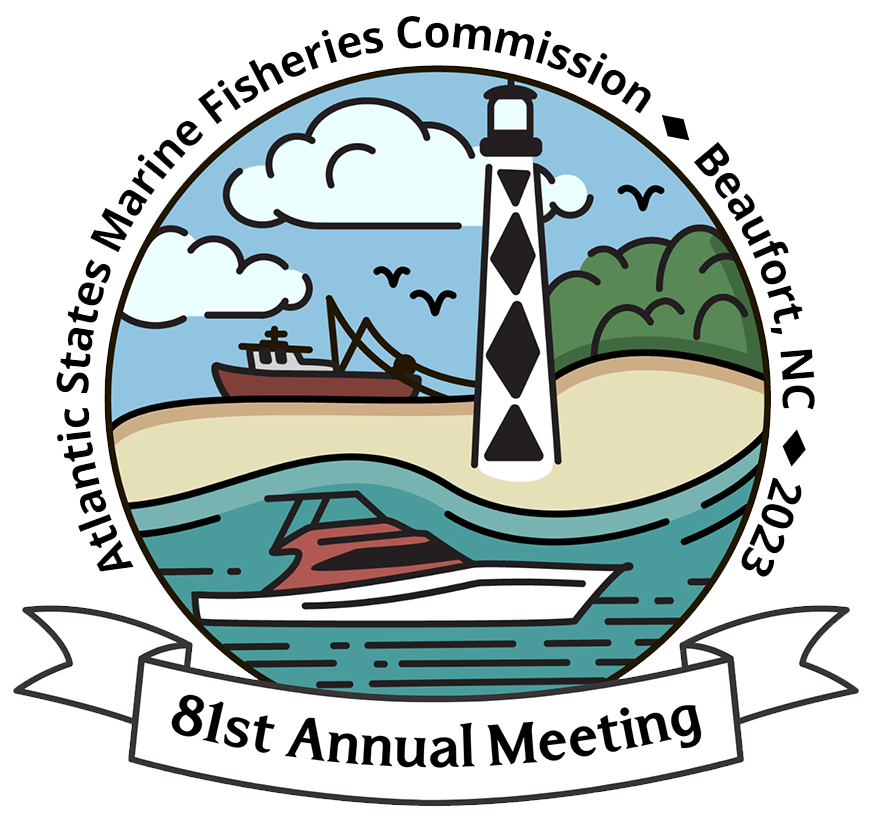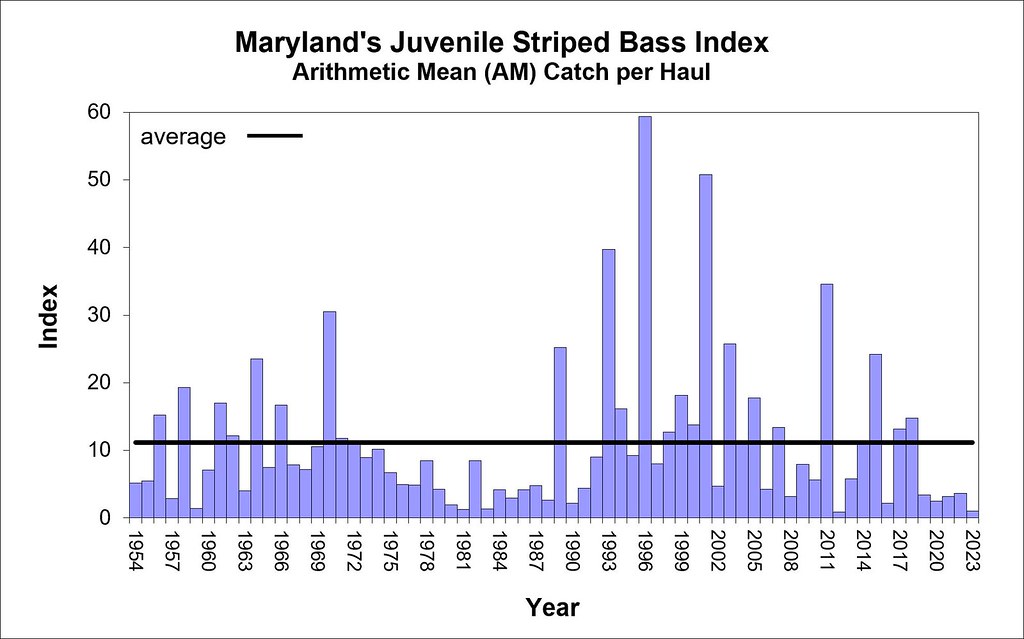ASMFC 2023 Annual Meeting Summary
ASMFC 2023 Annual Meeting Summary
Taylor Vavra | Vice President
Last Wednesday, October 18, 2023, the Atlantic Striped Bass Management Board met during the ASMFC 81st Annual Meeting and approved Draft Addendum II for public comment. This will be the second addendum to Amendment 7 to the Interstate Fishery Management Plan for Atlantic Striped Bass. It has become clear that the board continues to struggle with a solution to get the stock back on track and recovered by 2029. Six days prior to the meeting, the Maryland DNR (Department of Natural Resources) released the Chesapeake Bay 2023 young-of-year Striped Bass survey results. The unfortunate news is that we now have a fifth straight year of very poor recruitment, an index of 1.0, well below the long-term average of 11.1. The Maryland side of the Chesapeake Bay is by far the most important spawning area on the Atlantic coast with an estimated 65-90% of fish spawning and nursing within it. It is our belief that this board cannot and will not rebuild the stock with the provisions which arise from Addendum II. There are simply not enough new fish entering the stock and it is only a matter of time before we find ourselves witnessing a catastrophic collapse. Many anglers point to incredible fishing and while that might be the case in some isolated areas, the reality is that the 2015 year class is just that, a single year class of fish. What will follow that is exactly what we need to be concerned about, it is incredibly important to have a long term vision of the fishery.
Stripers Forever took the bold stance during the Amendment 7 process that there is only one thing will successfully rebuild the stock, an equitable (recreational and commercial) harvest moratorium. It did not become an option in Amendment 7, it was not an option in Addendum I and unfortunately for Striped Bass, it is not an option in Addendum II. Perhaps the next stock assessment will force the hand of the board, only time will tell. Between now and then, Striped Bass will suffer the consequences and we will be that much farther behind in finding a viable solution to rebuild the stock. Below are some of the main takeaways from the annual meeting. Once Addendum II is released for public comment, we will review it, do our best to simplify it and help make your voice heard in the most productive way possible.
- The board approved Addendum II for public comment and it will be released by the ASMFC sometime on or before October 31st. Public hearings will then commence in November and continue into December. Final action on Addendum II will likely take place at a meeting sometime in January. The goal would be to have new regulations in place for the 2024 fishing season. BUT…with commercial regulations likely to be impacted, the board made it clear that it would be very difficult or impossible to do so in 2024. Some commercial seasons begin soon-after and updating tags may be undoable. More on this in our action alert for public comment.
- Recreational options for both the ocean and Chesapeake Bay were further adjusted and in some cases simplified. There were also a few additions, most notable of which was an option to up the current slot limit to 30-33″. This is mind boggling, the board set out to protect the 2015 year class and we now have an option on the table to essentially track their growth and allow more to be removed from the stock. This will be one item to strongly oppose in your comments to the board.
- Mode splits for charter/for-hire remain in Addendum II and it is our belief that this is a dangerous slippery slope. Equity must play an important part in the rebuilding of the stock and we all must give in order to receive. Dividing recreational anglers will only create more animosity and confusion in regards to enforcement. Again, more on this in our action alert for public comment.
- Commercial options in Addendum II were greatly simplified and both the ocean and Chesapeake Bay fisheries will very likely see commercial quota reductions.
- While not talked about during the meeting, the reality is that Addendum II will likely only be a bridge for the 2024 seasons. A new stock assessment is due in late summer or early fall of 2024. Given the current trajectory of stock status, we tend to believe that the results will be very bad. If that is the case, the board will go back to the drawing board in an effort to further correct and ensure a rebuild by 2029. As that time, if things continue to go as they have, we may finally see the board with no choice but to enact stronger measures in the way of seasonal closures and perhaps a harvest moratorium.
From the ASMFC:
Atlantic Striped Bass Board Approves Draft Addendum II for Public Comment to Consider Measures to Reduce Fishing Mortality in 2024
Beaufort, NC – The Atlantic States Marine Fisheries Commission’s Atlantic Striped Bass Management Board approved for public comment Draft Addendum II to Amendment 7 to the Interstate Fishery Management Plan (FMP) for Atlantic Striped Bass. The Draft Addendum considers management measures designed to support stock rebuilding by reducing fishing mortality to the target in 2024.
The Board initiated the Draft Addendum in response to the low probability of meeting the 2029 stock rebuilding deadline if the unexpectedly high 2022 fishing mortality rate continues. The Draft Addendum builds upon the 2023 emergency action by considering management measures intended to reduce fishing mortality to the target level in 2024. Projections indicate that a 14.5% reduction in total removals relative to 2022 is needed to have a 50% chance of being at or below the fishing mortality target in 2024. For the recreational fishery, the Draft Addendum proposes recreational bag and size limit options for the ocean and Chesapeake Bay regions, including options with different limits for the for-hire modes. To address concerns about recreational filleting allowances and compliance with recreational size limits, the Draft Addendum includes an option that would establish minimum requirements for states that authorize at-sea/shore-side filleting of striped bass (e.g., racks must be retained). For the commercial fishery, the Draft Addendum proposes a quota reduction option that would reduce commercial quotas by up to 14.5%, with the final percent reduction to be determined by the Board.
For measures beyond 2024, the Board will consider the results of the upcoming 2024 stock assessment update to inform subsequent management action. To enable an expedited management response to the 2024 stock assessment update, the Draft Addendum proposes an option that would enable the Board to respond to the results of the stock assessment updates more quickly, via Board action, if the stock is not projected to rebuild by 2029.
The Draft Addendum will be posted to the website no later than October 31st at https://asmfc.org/about-us/public-input. A subsequent press release will provide the details on the public hearing schedule and how to submit written comments. The Board will meet to review submitted comments and consider final action on the addendum in January 2024 at the Commission’s Winter Meeting in Arlington, VA. For more information, please contact Emilie Franke, Fishery Management Plan Coordinator, at efranke@asmfc.org or 703.842.0740.
The press release can also be found at http://www.asmfc.org/uploads/file/653159e0PR28_AtlStripedBassDraftAddenumII_PublicComment.pdf
ADDITIONAL LINKS
- Atlantic Striped Bass Board 2023 Annual Meeting: Presentations (PDF)
- Atlantic Striped Bass Board 2023 Annual Meeting: Meeting Recording Audio/Video (YouTube)
- ASMFC 2023 Annual Meeting: 2023 Annual Meeting Summary (PDF)
ASMFC 81st Annual Meeting (10/18/23) & Chesapeake Bay 2023 YOY Report
ASMFC 81st Annual Meeting of the Atlantic Striped Bass Management Board
To register for the live webinar please go here: ASMFC 81st Annual Meeting- Striped Bass Management Board (GoToMeeting Webinar ID: 807-430-387)

ADDITIONAL LINKS
- Atlantic Striped Bass Board- Draft Agenda/ Meeting Overview/ Main Meeting Materials
- Atlantic Striped Bass Board- Supplemental Materials
- Atlantic Striped Bass Board- Supplemental Materials 2
Maryland Chesapeake Bay 2023 YOY (young-of-year) Survey Results
Unfortunately the Maryland DNR 2023 young-of-year survey has brought more bad news to the table. The juvenile Striped Bass index is dangerously low for a fifth consecutive year. The 2023 young-of-year index is 1.0, well below the long-term average of 11.1 and the second-worst spawn on record. It is very concerning that the Chesapeake commercial quota has seen no reduction. Between Menhaden and Striped Bass, the bay is being sucked dry of all life. The DNR is placing the blame on environmental factors, we don’t disagree with the possibility of that. But if that is true, we need to adjust management of the fishery to offset those factors as fixing those environmental issues is a much longer process. Let’s hope this news does some in good in the way of encouraging the ASMFC board to get a handle on commercial quota in the bay and also keep more conservation minded options in draft Addendum II.
ASMFC 2023 Summer Meeting Summary

ASMFC 2023 Summer Meeting Summary
Taylor Vavra | Vice President
The old proverb goes…the higher you climb the harder you fall, it really captures our feelings after the ASMFC striped bass board meeting on August 1, 2023. At the previous spring meeting we proclaimed a major victory for striped bass conservation in the way of unprecedented emergency action and the initiation of Addendum II. Let’s just say, things didn’t go so well at this meeting, and that is a gross understatement. The biggest factor being the decision by the board not to approve Addendum II to be released for public comment. This sets in motion a domino effect which will have massive implications on the rebuilding of the stock. The next review of Addendum II will take place at the October meeting and hopefully (can’t take anything for granted with this board) it will be released for public comment. Those hearings would be held sometime between the October and next board meeting in January of 2024. And herein lies the problem, assuming Addendum II is approved at the meeting in January of 2024, the board has already come to the conclusion that it would be too late for revised commercial regulations to be put in place.
So yet again, the can has been kicked down the road and ultimately the recreational sector will take on the brunt of the reductions aimed at rebuilding the stock. The only real positive takeaway from this meeting is the extension of the emergency action to continue to bridge the gap until Addendum II is approved. In this blog post the plan is to outline the major takeaways from this meeting, once a revised draft Addendum II is available ahead of the October meeting we will dive a little deeper.
- Addendum II was not approved for release and public comment. The timeline now places that process sometime after the October meeting with final action likely to take place at the following meeting in January of 2024.
- It will be too late for the implementation of revised 2024 commercial regulations and in turn we will likely not see those until 2025. The reasoning behind this was flimsy at best and mainly centered around the inability of states to be able to create physical tags in time. But why do all states have to implement revised commercial regulations at the same time? The southern states might be in that situation but the commercial season in the northern states starts much later. Clearly the focus is being placed on protecting the commercial sector and not rebuilding the stock.
- Emergency action was extended to be in place until Addendum II is finalized. The recreational fishery will continue to operate under a 28″-31″ size limit.
- Addendum II will likely produce a 14% reduction on the commercial side but its the fine print that counts. That reduction will be from the quota, not the landings. So, if a state does not max out it’s quota, it will essentially not be taking any reduction at all. This is totally backwards and is another example of the boards desire to prioritize commercial fishing over rebuilding the stock. Added to the list of reasons we believe there should be no commercial harvest of striped bass.
- Seasonal harvest closure options were removed for the recreational ocean fishery. This was particularly disappointing, we really believe that seasonal harvest closures would greatly benefit the stock. Areas like Raritan Bay and Jamaica Bay, when striped bass stage to move into the Hudson River to spawn, see immense angling pressure. After 4 straight poor spawns in the Chesapeake, we really need to do all we can to preserve and increase spawning in other major areas.
- Options for mode splitting for the charter for-hire were added which in reality would allow that sector to kill more fish. This is not the time for this, all parties involved in the fishery should be taking equal reductions to rebuild the stock. This will likely see a lot of backlash as we move though the public comment phase and we will be pushing to have it removed from Addendum II.
This was a tough meeting and we are very unhappy with the direction that the board has chosen to pursue. Recruitment (spawning) in the Chesapeake has been at an near all time low for 4 straight years and there is not indication that it will be any better in 2023. While that is really bad news for the stock it could end up being the saving grace as the board meets again in October. We hope that the board comes to realize that many of the options removed from and added to Addendum II will work against a recovery of the stock. Please stay tuned as things progress, the YOY (recruitment/spawn) data for the Chesapeake will be available soon.
From the ASMFC:
Arlington, VA – The Atlantic States Marine Fisheries Commission’s Atlantic Striped Bass Management Board extended the current emergency action through October 28, 2024 or until the implementation of Addendum II to Amendment 7 of the Interstate Fishery Management Plan. In May, the Board approved a 31-inch maximum size limit for the 2023 recreational fishery to reduce harvest of the strong 2015-year class. The 31-inch maximum size limit applies to all existing recreational fishery regulations where a higher (or no) maximum size applies, excluding the May Chesapeake Bay trophy fisheries which already prohibit harvest of fish less than 35 inches. All bag limits, seasons, and gear restrictions remain the same. All states and jurisdictions implemented the required measure by July 2, 2023.
The emergency action responds to the unprecedented magnitude of 2022 recreational harvest, which is nearly double that of 2021, and new stock rebuilding projections, which estimate the probability of the spawning stock rebuilding to its biomass target by 2029 drops from 97% under the lower 2021 fishing mortality rate to 15% if the higher 2022 fishing mortality rate continues each year.
The extension of the emergency action provides the Board time to develop and finalize Draft Addendum II, which will consider 2024 management measures designed to reduce fishing mortality to the target. Specifically, the Draft Addendum will propose options for the ocean recreational fishery, including modifications to the slot limit with harvest season closures as a secondary non-preferred option. It will also propose options for the Chesapeake Bay recreational fisheries, as well all commercial fisheries, including maximum size limits.
The Board made changes to the Draft Addendum’s options and sought additional analyses on the impacts of those revised options to the rebuilding of the resource. The Board will review a revised Draft Addendum and consider its approval for public comment in October at the Commission’s Annual Meeting. If approved, the document will be made available for public comment and the states/jurisdictions will conduct public hearings to solicit public comment throughout the fall/early winter. It’s anticipated that the Board will consider public comment and take final action in January at the Commission’s Winter Meeting. For more information, please contact Toni Kerns, Fisheries Policy Director, at tkerns@asmfc.org.
ADDITIONAL LINKS
- Atlantic Striped Bass Board Summer Meeting: 2023 Summer Meeting Summary (PDF)
- Atlantic Striped Bass Board Summer Meeting: Presentations (PDF)
- Atlantic Striped Bass Board Summer Meeting: Meeting Recording Audio/Video (YouTube)
Action Alert: VA Menhaden Fishery Gear Restrictions

Photo Credit: David Shupp
ACTION ALERT: VA Menhaden Fishery Gear Restrictions
Taylor Vavra | Vice President
Menhaden need your help! Menhaden are an important food source, not only for striped bass, also; whales, dolphins, red drum (redfish), weakfish, fluke, osprey, crab, the list goes on. Nearly all marine life benefits in some way from a healthy and abundant menhaden population. Omega Protein Corporation, owned by the Canadian multinational Cooke Inc., removes hundreds of millions of pounds of menhaden from the Atlantic ocean every year. In Virginia, they are allowed to remove 112 million pounds from the Virginia side of the Chesapeake Bay each year. Now it has been discovered that their methods and locations of fishing are doing even more damage to the bay and its marine life. Using purse seine nets in waters with a depth that is less than the length of the net is catastrophic in a variety of ways. But first, a little understanding of what a purse seine net is and how it operates is important.
A purse seine is a large wall of netting deployed around an entire area or school of fish. The seine has floats along the top line with a lead line threaded through rings along the bottom. Once a school of fish is located, skiffs encircles the school with the net. At that point the bottom of the net is left open for a period of time to allow bycatch (non-targeted species) to escape. The lead line is then pulled in, “pursing” the net closed on the bottom, preventing fish from escaping by swimming downward.

Illustration: NOAA
The issue being addressed by this petition revolves around the use of this type of net in water depths in which the bottom of the net sits directly on the seabed. In doing so, it not only prevents bycatch from escaping through the bottom of the net, but is also greatly disturbs the seabed. Sea grass and marine life who make the seabed their home are directly and gravely impacted. Omega Protein operates under the Marine Stewardship Council Sustainability Certification which requires that the net “has no contact with the seabed” in order to have low levels of bycatch. Supporting this petition is a no brainer, Omega Protein is using fishing gear improperly and violating the terms of their sustainability certification.
So how can you help? It’s really quite easy, an online petition has been established in Virginia, you can view it clicking here. You can quickly and easily submit your comments by clicking here. Below are a few important points to mention in your comments.
- Omega Protein is using purse seine nets improperly and in violation of the Marine Stewardship Council Sustainability Certification under which they operate.
- Use of these nets in shallow water, less than 60 feet, does not allow bycatch (non-targeted species) to escape.
- Use of these nets in shallow water, less than 60 feet, causes catastrophic damage to the seabed, seagrass and marine life.
- Restricting the depth in which these nets can be used will also help to avoid unnecessary net spills, tears and in turn a waste of the resource.
Please take a few minutes of your time to submit your comments and be part of the process. Accountability is an extremely important part of fisheries management and we all must do what we can to ensure that Omega Protein operates in a way which minimizes damage to the ecosystems in which they operate. Thank you for your continued support!
PETITION LINKS
- Petition Information: https://townhall.virginia.gov/l/viewpetition.cfm?petitionid=392
- Enter Your Comment On This Petition: https://townhall.virginia.gov/l/entercomment.cfm?petitionid=392









